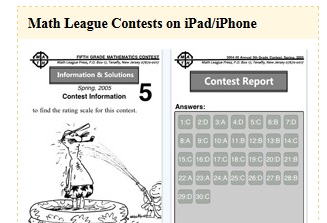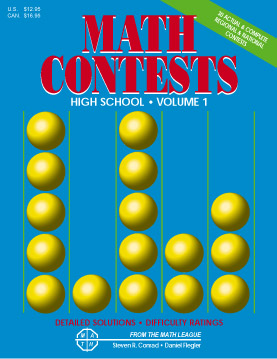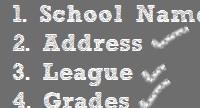General
- Details
- Parent Category: Math League Website
Ala-La-Miss Mathematics League
Ala-La-Miss Participating States: Alabama, Louisiana, Mississippi
California Mathematics League
Canadian National Mathematics League
Colorado Mathematics League
Florida Mathematics League
Georgia Mathematics League
Illinois Mathematics League
Indiana Mathematics League
Maryland Mathematics League
Math League Press
Math League Press Participating States: Arizona, Arkansas, Delaware, Hawaii, Idaho, Iowa, Kansas, Kentucky, Montana, Nebraska, Nevada, New Mexico, North Carolina, North Dakota, Oregon, South Carolina, South Dakota, Tennessee, Utah, West Virginia, Wyoming
Michigan Mathematics League
Minnesota Mathematics League
Missouri Mathematics League
New England Mathematics League
New England Participating States: Connecticut, Maine, Massachusetts, New Hampshire, Rhode Island, Vermont
New Jersey Mathematics League
New York Mathematics League
Ohio Mathematics League
Oklahoma Mathematics League
Pennsylvania Mathematics League
Texas State Mathematics League
Virginia Mathematics League
Washington Mathematics League
Wisconsin Mathematics League
International Participating Leagues
- Details
- Parent Category: Math League Website
Ala-La-Miss Mathematics League
Ala-La-Miss Participating States: Alabama, Louisiana, Mississippi
California Mathematics League
Canadian National Mathematics League
Colorado Mathematics League
Florida Mathematics League
Georgia Mathematics League
Illinois Mathematics League
Indiana Mathematics League
Maryland Mathematics League
Math League Press
Math League Press Participating States: Arizona, Arkansas, Delaware, Hawaii, Idaho, Iowa, Kansas, Kentucky, Montana, Nebraska, Nevada, New Mexico, North Carolina, North Dakota, Oregon, South Carolina, South Dakota, Tennessee, Utah, West Virginia, Wyoming
Michigan Mathematics League
Minnesota Mathematics League
Missouri Mathematics League
New England Mathematics League
New England Participating States: Connecticut, Maine, Massachusetts, New Hampshire, Rhode Island, Vermont
New Jersey Mathematics League
New York Mathematics League
Ohio Mathematics League
Oklahoma Mathematics League
Pennsylvania Mathematics League
Texas State Mathematics League
Virginia Mathematics League
Washington Mathematics League
Wisconsin Mathematics League
International Participating Leagues
- Details
- Parent Category: Math League Website
Ala-La-Miss Mathematics League
Ala-La-Miss Participating States: Alabama, Louisiana, Mississippi
California Mathematics League
Canadian National Mathematics League
Colorado Mathematics League
Florida Mathematics League
Georgia Mathematics League
Illinois Mathematics League
Indiana Mathematics League
Maryland Mathematics League
Math League Press
Math League Press Participating States: Arizona, Arkansas, Delaware, Hawaii, Idaho, Iowa, Kansas, Kentucky, Montana, Nebraska, Nevada, New Mexico, North Carolina, North Dakota, Oregon, South Carolina, South Dakota, Tennessee, Utah, West Virginia, Wyoming
Michigan Mathematics League
Minnesota Mathematics League
Missouri Mathematics League
New England Mathematics League
New England Participating States: Connecticut, Maine, Massachusetts, New Hampshire, Rhode Island, Vermont
New Jersey Mathematics League
New York Mathematics League
Ohio Mathematics League
Oklahoma Mathematics League
Pennsylvania Mathematics League
Texas State Mathematics League
Virginia Mathematics League
Washington Mathematics League
Wisconsin Mathematics League
International Participating Leagues
- Details
- Parent Category: Math League Website
Math Contest Newsletters 2025-2026 School Year
High School Newsletter December 2025
High School Newsletter November 2025
Math Contest Newsletters 2024-2025 School Year
Grade 6-7-8 School Newsletter 2025
High School Newsletter April 2025
High School Newsletter March 2025
High School Newsletter February 2025
High School Newsletter January 2025
High School Newsletter December 2024
High School Newsletter November 2024
Math Contest Newsletters 2023-2024 School Year
Grade 4-5-Algebra School Newsletter Spring 2024
Grade 6-7-8 School Newsletter 2024
High School Newsletter April 2024
High School Newsletter March 2024
High School Newsletter February 2024
High School Newsletter January 2024
High School Newsletter December 2023
High School Newsletter November 2023
Math Contest Newsletters 2022-2023 School Year
Grade 4-5-Algebra School Newsletter Spring 2023
Grade 6-7-8 School Newsletter 2023
High School Newsletter April 2023
High School Newsletter March 2023
High School Newsletter February 2023
High School Newsletter January 2023
High School Newsletter December 2022
High School Newsletter November 2022
Math Contest Newsletters 2021-2022 School Year
Grade 4-5-Algebra School Newsletter Spring 2022
Grade 6-7-8 School Newsletter 2022
High School Newsletter April 2022
High School Newsletter March 2022
High School Newsletter February 2022
High School Newsletter January 2022
High School Newsletter December 2021
High School Newsletter November 2021
Math Contest Newsletters 2020-2021 School Year
Grade 4-5-Algebra School Newsletter Spring 2021
Grade School Newsletter 2020-2021
High School Newsletter April 2021
High School Newsletter March 2021
High School Newsletter February 2021
High School Newsletter January 2021
High School Newsletter December 2020
High School Newsletter November 2020
Math Contest Newsletters 2019-2020 School Year
Grade 4-5-Algebra Newsletter Spring 2020
Grade School Newsletter 2019-2020
High School Newsletter March 2020
High School Newsletter February 2020
High School Newsletter January 2020
High School Newsletter December 2019
High School Newsletter November 2019
Math Contest Newsletters 2018-2019 School Year
Grade 4-5-Algebra Newsletter Spring 2019
High School Newsletter April 2019
High School Newsletter March 2019
High School Newsletter February 2019
High School Newsletter January 2019
High School Newsletter December 2018
High School Newsletter November 2018
Math Contest Newsletters 2017-2018 School Year
Grade 4-5-Algebra Newsletter April 2018
High School Newsletter April 2018
High School Newsletter March 2018
High School Newsletter February 2018
High School Newsletter January 2018
High School Newsletter December 2017
High School Newsletter November 2017
Math Contest Newsletters 2016-2017 School Year
Special: Selected Math League Rules 2016-2017
Grade 4-5 and Algebra Newsletter 2017
Grade School 6-7-8 Newsletter 2017
High School Newsletter April 2017
High School Newsletter March 2017
High School Newsletter February 2017
High School Newsletter January 2017
High School Newsletter December 2016
High School Newsletter November 2016
Math Contest Newsletters 2015-2016 School Year
Special: Selected Math League Rules 2015-2016
Grade 4-5 and Algebra Newsletter 2016
Grade School 6-7-8 Newsletter 2016
High School Newsletter April 2016
High School Newsletter March 2016
High School Newsletter February 2016
High School Newsletter January 2016
High School Newsletter December 2015
High School Newsletter November 2015
Math Contest Newsletters 2014-2015 School Year
Special: Selected Math League Rules 2014-2015
Grade 4-5 and Algebra Newsletter 2015
Grade School 6-7-8 Newsletter 2015
High School Newsletter April 2015
High School Newsletter March 2015
High School Newsletter February 2015
High School Newsletter January 2015
High School Newsletter December 2014
High School Newsletter November 2014
Math Contest Newsletters 2013-2014 School Year
Special: Selected Math League Rules 2013-2014
Grade School 4-5 and Algebra Newsletter 2014
Grade School 6-7-8 Newsletter 2014
High School Newsletter April 2014
High School Newsletter March 2014
High School Newsletter February 2014
High School Newsletter January 2014
High School Newsletter December 2013
High School Newsletter November 2013
Math Contest Newsletters 2012-2013 School Year
Special: Selected Math League Rules 2012
Grade School 4-5 and Algebra Newsletter 2013
Grade School 6-7-8 Newsletter 2013
High School Newsletter April 2013
High School Newsletter March 2013
High School Newsletter February 2013
High School Newsletter January 2013
High School Newsletter December 2012
High School Newsletter November 2012
Math Contest Newsletters 2011-2012 School Year
Special: Selected Math League Rules 2011
Grade School 4-5 and Algebra Newsletter 2012
Grade School 6-7-8 Newsletter 2012
High School Newsletter April 2012
High School Newsletter March 2012
High School Newsletter February 2012
High School Newsletter January 2012
High School Newsletter December 2011
High School Newsletter November 2011
Math Contest Newsletters 2010-2011 School Year
High School Newsletter April 2011
Grade School 6-7-8 Newsletter #1 2011
High School Newsletter March 2011
High School Newsletter February 2011
High School Newsletter January 2011
High School Newsletter December 2010
High School Newsletter November 2010
Math Contest Newsletters 2009-2010 School Year
Grade School 6-7-8 Newsletter #1 2010
High School Newsletter April 2010
High School Newsletter March 2010
High School Newsletter February 2010
High School Newsletter January 2010
High School Newsletter December 2009
High School Newsletter November 2009
Math Contest Newsletters 2008-2009 School Year
Math League News #1, Nov., 2008
Math League News #2, Dec., 2008
Math League News #3, Jan., 2009
Math League News #4, Feb., 2009
Math League News #5, Mar., 2009
Math League News #6, Apr., 2009
![]() To view PDF files, download and install Acrobat Reader (free).
To view PDF files, download and install Acrobat Reader (free).
- Details
- Parent Category: Math League Website
To report your school's scores, please follow the instructions on the outside of the white envelope that contained the contests. (For security purposes, that information is not listed here.) If you do not have your school account number, help is available at the Internet Scoring Center login screen.
If you have any questions, you can contact us.
- Details
- Parent Category: Math League Website
Comments or questions? Email This email address is being protected from spambots. You need JavaScript enabled to view it. or call either Dan at (201) 568-6328 or Steve at (516) 365-5656.
For questions related to the online shopping system or web site, you can also email This email address is being protected from spambots. You need JavaScript enabled to view it..
- Details
- Parent Category: Math League Website
- Details
- Parent Category: Math League Website
Below, please enter your school information and click "add school information". This will add your school information to your cart. Once you do that, you can continue to checkout by clicking the Continue Checkout link at the bottom of the page.
- Details
- Parent Category: Math League Website
If you are paying an invoice you received from The Math League you need to use this section of the form.
Enter your school account number and/or name, and the order number sent to you. You can enter the amount you are paying on the cart, and then choose a payment option.
- Details
- Parent Category: Math League Website
| Official Contest Dates 2023-2024 School Year | ||||
|---|---|---|---|---|
| Contest Level | Registration Deadline * |
Shipping Date | Contest Date | Registration Fee (Prices include shipping) |
| 4th Grade | February 28, 2024 | March | April 15th or later | $45 per set of 30 |
| 5th Grade | February 28, 2024 | March | April 15th or later | $45 per set of 30 |
| 6th Grade |
January 31, 2024 |
January | 3rd Tues. in Feb. - February 20, 2024 or 4th Tues. in Feb. - February 27, 2024 |
$45 per set of 30 |
| 7th Grade | January 31, 2024 | January | 3rd Tues. in Feb. - February 20, 2024 or 4th Tues. in Feb. - February 27, 2024 |
$45 per set of 30 |
| 8th Grade | January 31, 2024 | January | 3rd Tues. in Feb. - February 20, 2024 or 4th Tues. in Feb. - February 27, 2024 |
$45 per set of 30 |
| Algebra Course 1 | February 28, 2024 | March | April 15th or later | $45 per set of 30 |
| High School |
October 15, 2023 |
October | 6 Contests, Oct.-Mar. | $100 / 6 contests, 30 of each |
|
* Late registrations will be accepted. |
||||
- Details
- Parent Category: Math League Website
Algebra Course 1 Contest
Math League's Algebra Course 1 Contests are a great way to motivate students learning algebra for the first time. The questions range from basic algebra skills, to more difficult problems, requiring creative solutions by applying algebra course 1 techniques. A wide variety of word problems are included on each contest, in addition to computational problems, to stress the value of applied algebra techniques. These contests are provided for intraschool competition, and come with certificates of merit for your school's high scoring students, and one of our High School Contest problem books for your school's top scorer. Here's a quote from one of last year's Algebra Course 1 students who participated in our contest: "I hope you keep making those tests. It really gets your brain to work" -Amber L. Contest Format: Each contest consists of 30 multiple-choice questions that you can do in 30 minutes. On each 3-page contest, the questions on the 1st page are generally straightforward, those on the 2nd page are moderate in difficulty, and those on the 3rd page are more difficult. The questions require no more knowledge than that of a first year high school algebra course. |
| Sample Algebra 1 Contest (PDF - 195k) • Solutions (PDF - 208k) Dates / Fees • Register Online • Print Order Form Rules • FAQ • Check School Registration |




